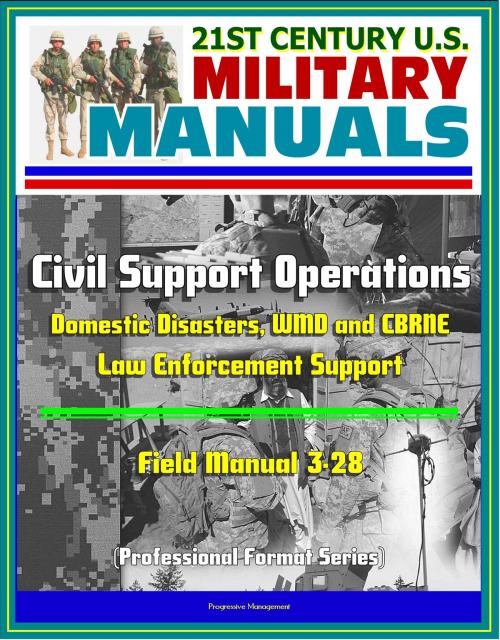21st Century U.S. Military Manuals: Civil Support Operations - Field Manual 3-28 - Domestic Disasters, WMD and CBRNE, Law Enforcement Support (Professional Format Series)
Nonfiction, Social & Cultural Studies, Political Science, Politics, Law Enforcement, History, Military, Strategy| Author: | Progressive Management | ISBN: | 9781301768011 |
| Publisher: | Progressive Management | Publication: | November 27, 2012 |
| Imprint: | Smashwords Edition | Language: | English |
| Author: | Progressive Management |
| ISBN: | 9781301768011 |
| Publisher: | Progressive Management |
| Publication: | November 27, 2012 |
| Imprint: | Smashwords Edition |
| Language: | English |
Professionally converted for accurate flowing-text e-book format reproduction, this Army Field Manual provides keystone Army doctrine for civil support operations. It expands on the discussion of civil support operations, the fourth element of full spectrum operations, in FM 3-0. This manual focuses on the planning, preparation, execution, and assessment of civil support operations, which are conducted within the United States and its territories. It discusses the role of Army forces cooperating with and supporting civilian organizations in domestic operational environments, with particular emphasis on how operations conducted by Army forces within the United States differ from full spectrum operations conducted overseas.
All civil support operations buttress the capabilities of civil authorities within the United States. The mechanisms that regulate civil support come from law, policy, regulation, and directive. Civil support operations require Army leaders to understand an environment shaped primarily by federal, state, local, and tribal agencies, and circumscribed by law. Nowhere is this more striking than in the roles of the National Guard. In sharp contrast to stability operations, Army forces may conduct civil support operations with National Guard forces responding under the direction of a governor or alongside active duty forces as part of a coordinated national response. FM 3-28 explains the reasons for the division of forces and provides considerations for the entire Army, including all three components: Regular Army, Army Reserve, and Army National Guard.
Chapter 1 * THE DOMESTIC ENVIRONMENT * The Army and Civil Support Operations * The Constitution of the United States and the Army * Army Components and Civil Support Operations * Duty Status of Forces Conducting Civil Support Operations * Key Aspects of Domestic Operations * Primary Civil Support Tasks * Fundamentals of Civil Support Operations * Training for Civil Support Operations * Chapter 2 * A COMPREHENSIVE APPROACH FOR CIVIL SUPPORT * National Policy for Domestic Emergencies * Tiered Response from Local through National Level * National Guard Civil Support Operations * Federal Military Civil Support Operations * Chapter 3 * PROVIDE SUPPORT FOR DOMESTIC DISASTERS * The Nature of a Disaster * Responsibility for Disaster Response * Initial Response from Local and State Authorities * National Guard Disaster Response * Federal Military Disaster Response * Phases of Disaster Response Operations * Considerations for Disaster Response Operations * Chapter 4 * PROVIDE SUPPORT FOR DOMESTIC CBRNE INCIDENTS * Potential Consequences of Domestic CBRNE Incidents * Civilian CBRNE Incident Response * National Guard CBRNE Incident Response * Federal Military CBRNE Incident Response * Support for Pandemic Disease Outbreaks * Considerations for Domestic CBRNE Incident Response Operations * Chapter 5 * PROVIDE SUPPORT FOR DOMESTIC CIVILIAN LAW ENFORCEMENT AGENCIES * Principal Authorities for Support to Domestic Civilian Law Enforcement Agencies * Main Types of Missions for Support to Domestic Civilian Law Enforcement Agencies * Protection Against Terrorism * Considerations for Support to Domestic Civilian Law Enforcement Agencies * Chapter 6 * PROVIDE OTHER DESIGNATED SUPPORT * Types of Designated Support * Requests for Other Designated Support * Chapter 7 * LEGAL CONSIDERATIONS * Powers of a State Governor * Authorities for Federal Military Support * The Posse Comitatus Act * Federal Military Forces and Civil Disturbance * Mobilization of the Reserve Component * Rules for the Use of Force * Intelligence Rules and Restrictions * Isolation and Quarantine Authorities * Personal Liability * Chapter 8 * SUSTAINMENT—LOGISTICS AND PERSONNEL SERVICES
Professionally converted for accurate flowing-text e-book format reproduction, this Army Field Manual provides keystone Army doctrine for civil support operations. It expands on the discussion of civil support operations, the fourth element of full spectrum operations, in FM 3-0. This manual focuses on the planning, preparation, execution, and assessment of civil support operations, which are conducted within the United States and its territories. It discusses the role of Army forces cooperating with and supporting civilian organizations in domestic operational environments, with particular emphasis on how operations conducted by Army forces within the United States differ from full spectrum operations conducted overseas.
All civil support operations buttress the capabilities of civil authorities within the United States. The mechanisms that regulate civil support come from law, policy, regulation, and directive. Civil support operations require Army leaders to understand an environment shaped primarily by federal, state, local, and tribal agencies, and circumscribed by law. Nowhere is this more striking than in the roles of the National Guard. In sharp contrast to stability operations, Army forces may conduct civil support operations with National Guard forces responding under the direction of a governor or alongside active duty forces as part of a coordinated national response. FM 3-28 explains the reasons for the division of forces and provides considerations for the entire Army, including all three components: Regular Army, Army Reserve, and Army National Guard.
Chapter 1 * THE DOMESTIC ENVIRONMENT * The Army and Civil Support Operations * The Constitution of the United States and the Army * Army Components and Civil Support Operations * Duty Status of Forces Conducting Civil Support Operations * Key Aspects of Domestic Operations * Primary Civil Support Tasks * Fundamentals of Civil Support Operations * Training for Civil Support Operations * Chapter 2 * A COMPREHENSIVE APPROACH FOR CIVIL SUPPORT * National Policy for Domestic Emergencies * Tiered Response from Local through National Level * National Guard Civil Support Operations * Federal Military Civil Support Operations * Chapter 3 * PROVIDE SUPPORT FOR DOMESTIC DISASTERS * The Nature of a Disaster * Responsibility for Disaster Response * Initial Response from Local and State Authorities * National Guard Disaster Response * Federal Military Disaster Response * Phases of Disaster Response Operations * Considerations for Disaster Response Operations * Chapter 4 * PROVIDE SUPPORT FOR DOMESTIC CBRNE INCIDENTS * Potential Consequences of Domestic CBRNE Incidents * Civilian CBRNE Incident Response * National Guard CBRNE Incident Response * Federal Military CBRNE Incident Response * Support for Pandemic Disease Outbreaks * Considerations for Domestic CBRNE Incident Response Operations * Chapter 5 * PROVIDE SUPPORT FOR DOMESTIC CIVILIAN LAW ENFORCEMENT AGENCIES * Principal Authorities for Support to Domestic Civilian Law Enforcement Agencies * Main Types of Missions for Support to Domestic Civilian Law Enforcement Agencies * Protection Against Terrorism * Considerations for Support to Domestic Civilian Law Enforcement Agencies * Chapter 6 * PROVIDE OTHER DESIGNATED SUPPORT * Types of Designated Support * Requests for Other Designated Support * Chapter 7 * LEGAL CONSIDERATIONS * Powers of a State Governor * Authorities for Federal Military Support * The Posse Comitatus Act * Federal Military Forces and Civil Disturbance * Mobilization of the Reserve Component * Rules for the Use of Force * Intelligence Rules and Restrictions * Isolation and Quarantine Authorities * Personal Liability * Chapter 8 * SUSTAINMENT—LOGISTICS AND PERSONNEL SERVICES















